外语系英语专业毕业论文大纲
英语毕业论文提纲

英语毕业论文提纲英语毕业论文提纲引言在大学学习的最后阶段,毕业论文是每位学生必须完成的重要任务。
对于英语专业的学生来说,撰写一篇优秀的英语毕业论文是一项具有挑战性的任务。
本文将探讨英语毕业论文的提纲,为学生们提供一些建议和指导,帮助他们顺利完成这一重要的学术任务。
一、选题与研究背景1. 选题的重要性选题是一篇毕业论文的基础,它决定了研究的方向和内容。
学生应该选择一个有足够研究价值和学术意义的课题,以确保论文的质量和深度。
2. 研究背景的分析在确定选题之后,学生应该对研究背景进行详细的分析。
这包括相关研究领域的文献综述,以及当前研究的热点和问题。
通过对研究背景的分析,学生可以更好地定位自己的研究内容,并为论文的写作提供基础。
二、研究目的与研究问题1. 研究目的的设定在确定研究目的时,学生应该明确自己的研究目标和意义。
研究目的可以是填补已有研究的空白,解决实际问题,或者提出新的理论观点。
通过设定明确的研究目的,学生可以更好地组织和展开自己的研究。
2. 研究问题的提出研究问题是研究的核心,它决定了研究的方向和方法。
学生应该提出明确、具体、可操作的研究问题,以确保自己的研究能够得到有效的解答。
在提出研究问题时,学生可以参考前人的研究成果,结合自己的兴趣和专业知识,提出具有研究价值的问题。
三、研究方法与数据收集1. 研究方法的选择研究方法是研究的工具和手段,它决定了研究的可行性和可信度。
学生应该选择合适的研究方法,以确保自己的研究能够得到有效的结果。
常用的研究方法包括实证研究、文献综述、问卷调查等,学生可以根据自己的研究目的和问题选择合适的方法。
2. 数据收集的方法数据收集是研究的重要环节,它决定了研究结果的可靠性和有效性。
学生应该选择合适的数据收集方法,以确保自己能够获得准确和全面的数据。
常用的数据收集方法包括实地调研、实验观察、网络调查等,学生可以根据自己的研究对象和条件选择合适的方法。
四、研究结果与讨论1. 研究结果的呈现在撰写论文时,学生应该清晰、准确地呈现自己的研究结果。
关于英语专业毕业论文提纲优质范文.doc

英语专业毕业论文提纲范文一、英语谚语的概述1.1.对谚语的一般定义,并概括英语谚语的基本特点(3—5条)1.2.结合谚语与语言的关系,简要论述英语谚语来源的一般性概述这一部分大体写2000字。
二、西方的宗教传统与英语谚语的本源关联2.1对基督教的历史做一简单的概述,同时对《圣经》对基督教的核心意义与价值做一简单的说明2.1.1. 简述西方的宗教传统,或者基督教的历史2.1.2. 对基督教的基本信义做一简单的概述,从下述几个方面:(1)对基督教的只信仰一个唯一的上帝,不容许进行偶像崇拜;(2)原罪的观念与救赎的观念:涉及末世审判、救赎恩典和得救的观念(3)爱是基督教信仰的核心,核心是爱上帝,同时爱每个人归根结底,基督教是一种高级的精神性宗教,深深地浸透入了西方世界的每一个角落2.2英语谚语与基督教的关系,特别是《圣经》的英译对英语的影响(1)《圣经》历史上的英译本,主要讲钦定本的诞生和影响(譬如扩大了英语的词汇量、增强了英语的表意功能、增加了英语的表意手段等等)(2)通过一些简单的例证来说明从拉丁语翻译到英语这一过程的影响与意义(如可以举例一些特殊的词语、句式等说明,做好这一部分关键是找到好的研究资料)三、对源于《圣经》的谚语进行分析,揭示其宗教、文化内涵(选取若干源于《圣经》的谚语进行具体的、细致的分析,以揭示谚语背后的宗教内涵和英语所负载的宗教文化意义。
)1.选取15—20条有代表性的谚语进行分析,(1)简述一下选取分析对象的标准首先这些谚语必须来源于《圣经》或者有《圣经》直接引伸出来,其次这些谚语必须是应用较广,家喻户晓,且包含特定的智慧(2)对这些谚语进行分析我们的分析角度或方法是:1、要将这些谚语放到《圣经》的文本中去,也就是要将其放回到具体的语境中,在具体的故事或圣经人物的言说中领会这些谚语的内涵2、可以适当的结合这些谚语的修辞、句式结构等来分析2.对上述谚语分析之后,从若干角度进行文化内涵的总结和概括这些谚语的内在价值:道德规范、人生智慧、这些谚语的功能:宗教教化功能、规导劝慰功能、(这些价值功能关键的根据所选谚语的分析来确定,有新的发现可适当再添加)这一部分为本文的主体部分,在3500字左右附:拟订提纲的步骤与方法第一步,明确文章的大小题目。
关于英语专业毕业论文大纲
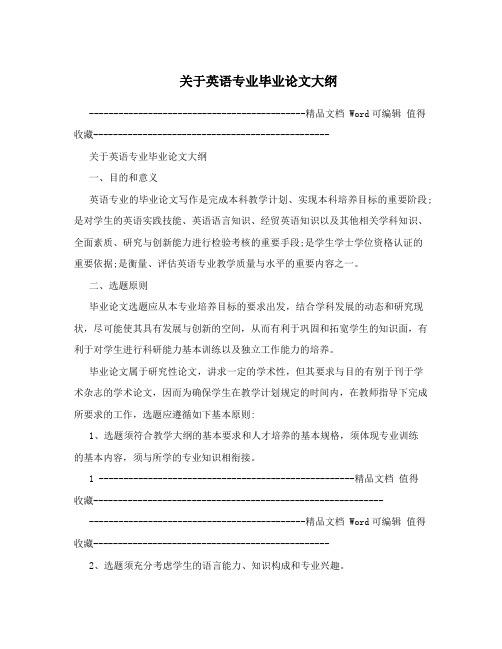
关于英语专业毕业论文大纲--------------------------------------------精品文档 Word可编辑值得收藏------------------------------------------------关于英语专业毕业论文大纲一、目的和意义英语专业的毕业论文写作是完成本科教学计划、实现本科培养目标的重要阶段;是对学生的英语实践技能、英语语言知识、经贸英语知识以及其他相关学科知识、全面素质、研究与创新能力进行检验考核的重要手段;是学生学士学位资格认证的重要依据;是衡量、评估英语专业教学质量与水平的重要内容之一。
二、选题原则毕业论文选题应从本专业培养目标的要求出发,结合学科发展的动态和研究现状,尽可能使其具有发展与创新的空间,从而有利于巩固和拓宽学生的知识面,有利于对学生进行科研能力基本训练以及独立工作能力的培养。
毕业论文属于研究性论文,讲求一定的学术性,但其要求与目的有别于刊于学术杂志的学术论文,因而为确保学生在教学计划规定的时间内,在教师指导下完成所要求的工作,选题应遵循如下基本原则:1、选题须符合教学大纲的基本要求和人才培养的基本规格,须体现专业训练的基本内容,须与所学的专业知识相衔接。
1 ----------------------------------------------------精品文档值得收藏----------------------------------------------------------- --------------------------------------------精品文档 Word可编辑值得收藏------------------------------------------------2、选题须充分考虑学生的语言能力、知识构成和专业兴趣。
3、选题的类型应多种多样,力求有益于学生综合运用多学科的理论知识与技能,有利于培养学生独立工作的能力。
英语专业毕业论文大纲
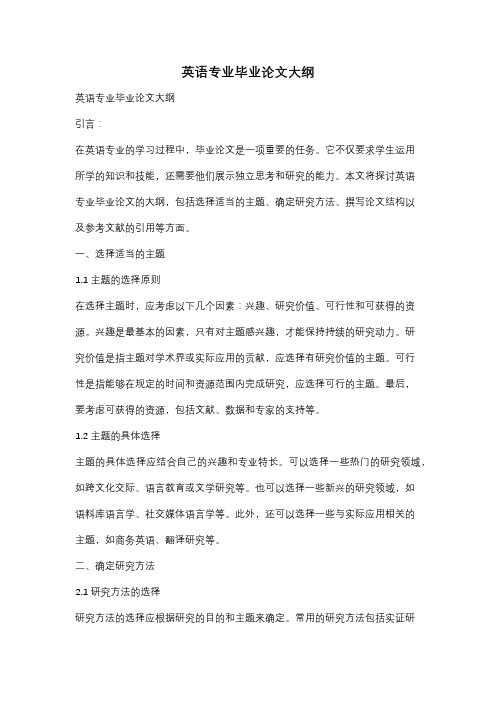
英语专业毕业论文大纲英语专业毕业论文大纲引言:在英语专业的学习过程中,毕业论文是一项重要的任务。
它不仅要求学生运用所学的知识和技能,还需要他们展示独立思考和研究的能力。
本文将探讨英语专业毕业论文的大纲,包括选择适当的主题、确定研究方法、撰写论文结构以及参考文献的引用等方面。
一、选择适当的主题1.1 主题的选择原则在选择主题时,应考虑以下几个因素:兴趣、研究价值、可行性和可获得的资源。
兴趣是最基本的因素,只有对主题感兴趣,才能保持持续的研究动力。
研究价值是指主题对学术界或实际应用的贡献,应选择有研究价值的主题。
可行性是指能够在规定的时间和资源范围内完成研究,应选择可行的主题。
最后,要考虑可获得的资源,包括文献、数据和专家的支持等。
1.2 主题的具体选择主题的具体选择应结合自己的兴趣和专业特长。
可以选择一些热门的研究领域,如跨文化交际、语言教育或文学研究等。
也可以选择一些新兴的研究领域,如语料库语言学、社交媒体语言学等。
此外,还可以选择一些与实际应用相关的主题,如商务英语、翻译研究等。
二、确定研究方法2.1 研究方法的选择研究方法的选择应根据研究的目的和主题来确定。
常用的研究方法包括实证研究、文献综述、案例研究和问卷调查等。
实证研究是通过实际观察和实验来验证假设或推断的方法;文献综述是通过对已有文献进行综合分析和总结来回答研究问题;案例研究是通过对具体案例的深入研究来揭示一般规律;问卷调查是通过设计问卷并对受访者进行调查来收集数据。
2.2 数据的收集和分析根据研究方法的选择,需要采集相应的数据,并进行分析。
数据的收集可以通过实地调研、访谈、问卷调查、文献查阅等方式进行。
数据的分析可以采用定性分析和定量分析两种方法。
定性分析是通过对数据进行分类、整理和归纳来获取结论;定量分析是通过数学和统计方法对数据进行计算和分析来获取结论。
三、撰写论文结构3.1 论文的结构论文的结构一般包括引言、文献综述、研究方法、研究结果、讨论和结论等部分。
英语专业毕业论文写作教学大纲简介

*
教学方法及评估标准
01
课堂面授、课堂讨论、网络资源利用和互动
教学方法:
02
课堂出勤率8%,平时作业及课内外互动22%,毕业论文70%
教学评估:
03
< 60(不及格);60-69(及格);70-84(中等);85-92(良好);93-100(优秀)
评分标准:
*
毕业论文的基本概念
论文(Thesis) 选题(Subject) 论题(Thesis ) 主题(Theme) 话题(Topic) 提纲(Outline) 题目(Title)
*
《英语专业毕业论文写作》 教学大纲简介
第一讲:概念与要求 2011年2月23日
汇报人姓名
教学目的
了解英语专业毕业论文的基本要求
了解英语论文写作的不同过程
了解、掌握英语论文的选题和开题
了解、掌握英语论文的撰写规范
了解英语论文的评价标准
完成一篇5000字符合规范要求的英语毕业论文
01
03
02
04
05
选方向(Select a subject)
2
定题目(Choose a topic)
拟提纲(Write an outline) Weeks 2~3
写初稿(Draft) Weeks 5~7; 8~10; 11~13
复修改(Revise according to adviser)
定终稿(Finalize official copy) Week 14
*
语 言 学 语言与文化
语法(Grammar) 句法(Syntax) 词汇(Idioms, proverbs, prepositions, slangs, euphemism, net language) 比较(Languages)
英语毕业论文的提纲范文3篇
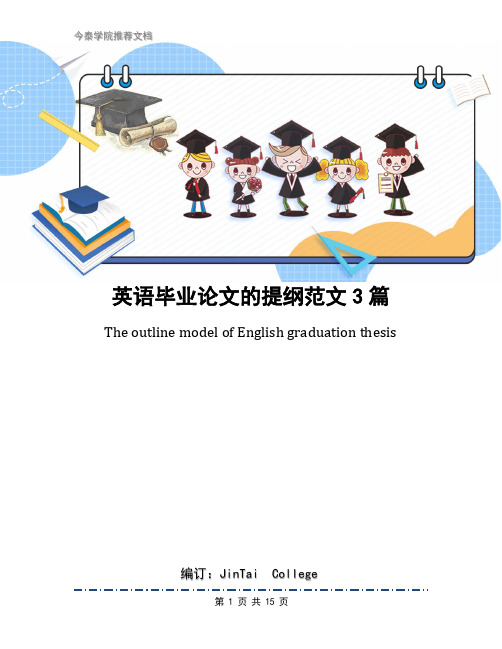
英语毕业论文的提纲范文3篇The outline model of English graduation thesis编订:JinTai College英语毕业论文的提纲范文3篇前言:论文格式就是指进行论文写作时的样式要求,以及写作标准,就是论文达到可公之于众的标准样式和内容要求,论文常用来进行科学研究和描述科研成果文章。
本文档根据论文格式内容要求和特点展开说明,具有实践指导意义,便于学习和使用,本文下载后内容可随意调整修改及打印。
本文简要目录如下:【下载该文档后使用Word打开,按住键盘Ctrl键且鼠标单击目录内容即可跳转到对应篇章】1、篇章1:英语毕业论文的提纲范文2、篇章2:毕业论文提纲范文3、篇章3:毕业论文提纲范文篇章1:英语毕业论文的提纲范文论文提纲最起码要能清楚的显示您论文的研究内容以及研究思路。
下面内容由小泰为大家分享英语毕业论文的提纲范文,一起来看看吧!Introduction0.1 Salman Rushdie and Midnight's Children0.2 Literature Review0.3 Significance of the ThesisChapter One The Carnival Rhetoric in Midnight's Children1.1 Carnival Language1.1.1 Language of Heteroglossia1.1.2 Linguistic Deviation1.2 Carnival Rhetorical Devices1.2.1 The Use of Metaphor1.2.2 The Use of Satire1.2.3 The Use of Pun1.3 Sum-upChapter Two The Carnival Characters in Midnight's Children2.1 Women's Carnivalesque Acts2.1.1 Widow2.1.2 Witch2.1.3 Unfaithful Wives2.2 Saleem's Carnivalesque Acts2.2.1 Grotesque Appearance and Eccentric Behavior2.2.2 Turning into Clown2.2.3 Crowning and Uncrowning2.3 Sum-upChapter Three Intertextual Dialogue in Midnight's Children3.1 Intertextual Dialogue between History and the Text3.1.1 National Allegory3.1.2 Fictionalization of National History3.2 Intertextual Dialogue between Pretexts and the Text3.2.1 Borrowings from Western Culture3.2.2 Borrowings from Indian Culture3.3 Intertextual Dialogue within the Text3.3.1 Palimpsest3.3.2 Polyphony3.4 Sum-upConclusionThis conclusionFocusing on contemporary forms of narrative, Hutcheon argues that postmodernistfiction embodies several carnivalesque structures. Firstly, in its metafictional preoccupationsand its tendency to foreground the artifice of literary construction, contemporary narrativeenacts a carnivalesque rebellion against the official ideology of realism (Hutcheon, 1988:83-4)。
英语专业毕业论文 教学大纲
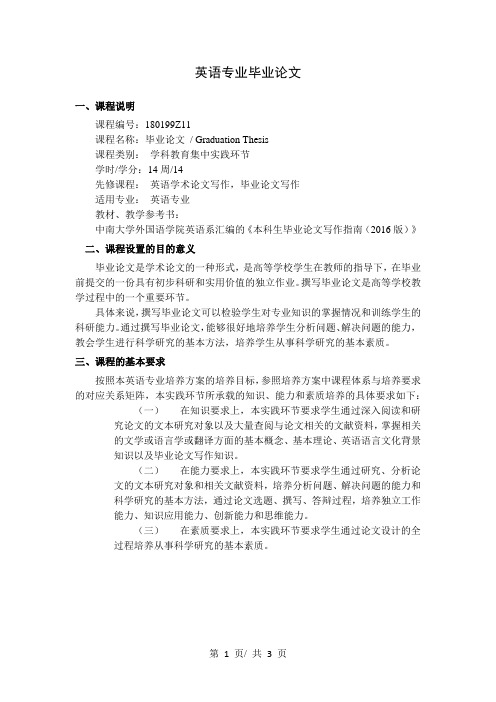
英语专业毕业论文一、课程说明课程编号:180199Z11课程名称:毕业论文/ Graduation Thesis课程类别:学科教育集中实践环节学时/学分:14周/14先修课程:英语学术论文写作,毕业论文写作适用专业:英语专业教材、教学参考书:中南大学外国语学院英语系汇编的《本科生毕业论文写作指南(2016版)》二、课程设置的目的意义毕业论文是学术论文的一种形式,是高等学校学生在教师的指导下,在毕业前提交的一份具有初步科研和实用价值的独立作业。
撰写毕业论文是高等学校教学过程中的一个重要环节。
具体来说,撰写毕业论文可以检验学生对专业知识的掌握情况和训练学生的科研能力。
通过撰写毕业论文,能够很好地培养学生分析问题、解决问题的能力,教会学生进行科学研究的基本方法,培养学生从事科学研究的基本素质。
三、课程的基本要求按照本英语专业培养方案的培养目标,参照培养方案中课程体系与培养要求的对应关系矩阵,本实践环节所承载的知识、能力和素质培养的具体要求如下:(一)在知识要求上,本实践环节要求学生通过深入阅读和研究论文的文本研究对象以及大量查阅与论文相关的文献资料,掌握相关的文学或语言学或翻译方面的基本概念、基本理论、英语语言文化背景知识以及毕业论文写作知识。
(二)在能力要求上,本实践环节要求学生通过研究、分析论文的文本研究对象和相关文献资料,培养分析问题、解决问题的能力和科学研究的基本方法,通过论文选题、撰写、答辩过程,培养独立工作能力、知识应用能力、创新能力和思维能力。
(三)在素质要求上,本实践环节要求学生通过论文设计的全过程培养从事科学研究的基本素质。
四、教学内容、重点难点及教学设计五、实践教学内容和基本要求学生根据自己的意愿确定论文选题方向,与论文指导老师联系讨论选题。
学生认真阅读《本科毕业论文写作指南》,在指导老师的指导下,配合论文题目三审进行论文题目的修改或更换,确定好论文题目。
在指导老师的指导下广泛查阅相关资料,完成论文写作提纲。
《英语专业 毕业论文》教学大纲
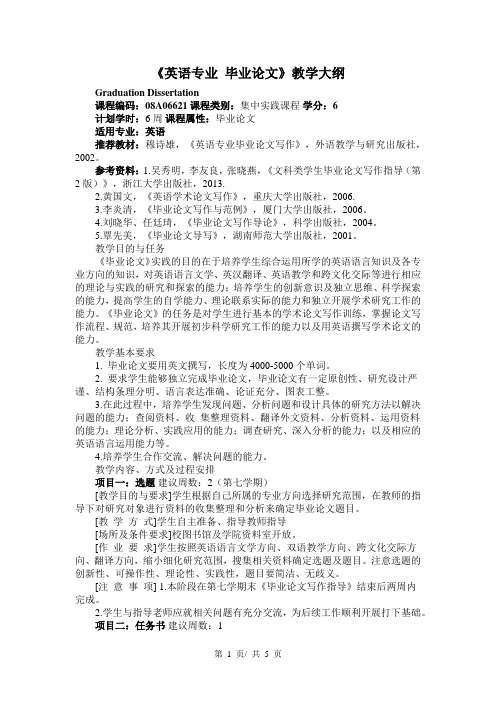
《英语专业毕业论文》教学大纲Graduation Dissertation课程编码:08A06621课程类别:集中实践课程学分:6计划学时:6周课程属性:毕业论文适用专业:英语推荐教材:穆诗雄,《英语专业毕业论文写作》,外语教学与研究出版社,2002。
参考资料:1.吴秀明,李友良,张晓燕,《文科类学生毕业论文写作指导(第2版)》,浙江大学出版社,2013.2.黄国文,《英语学术论文写作》,重庆大学出版社,2006.3.李炎清,《毕业论文写作与范例》,厦门大学出版社,2006。
4.刘晓华、任廷琦,《毕业论文写作导论》,科学出版社,2004。
5.覃先美,《毕业论文导写》,湖南师范大学出版社,2001。
教学目的与任务《毕业论文》实践的目的在于培养学生综合运用所学的英语语言知识及各专业方向的知识,对英语语言文学、英汉翻译、英语教学和跨文化交际等进行相应的理论与实践的研究和探索的能力;培养学生的创新意识及独立思维、科学探索的能力,提高学生的自学能力、理论联系实际的能力和独立开展学术研究工作的能力。
《毕业论文》的任务是对学生进行基本的学术论文写作训练,掌握论文写作流程、规范,培养其开展初步科学研究工作的能力以及用英语撰写学术论文的能力。
教学基本要求1. 毕业论文要用英文撰写,长度为4000-5000个单词。
2. 要求学生能够独立完成毕业论文,毕业论文有一定原创性、研究设计严谨、结构条理分明、语言表达准确、论证充分、图表工整。
3.在此过程中,培养学生发现问题、分析问题和设计具体的研究方法以解决问题的能力;查阅资料、收集整理资料、翻译外文资料、分析资料、运用资料的能力;理论分析、实践应用的能力;调查研究、深入分析的能力;以及相应的英语语言运用能力等。
4.培养学生合作交流、解决问题的能力。
教学内容、方式及过程安排项目一:选题建议周数:2(第七学期)[教学目的与要求]学生根据自己所属的专业方向选择研究范围,在教师的指导下对研究对象进行资料的收集整理和分析来确定毕业论文题目。
英语专业毕业论文提纲
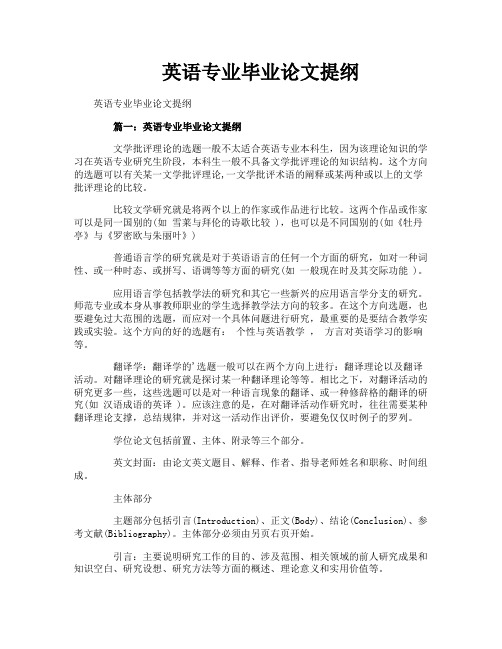
英语专业毕业论文提纲英语专业毕业论文提纲篇一:英语专业毕业论文提纲文学批评理论的选题一般不太适合英语专业本科生,因为该理论知识的学习在英语专业研究生阶段,本科生一般不具备文学批评理论的知识结构。
这个方向的选题可以有关某一文学批评理论,一文学批评术语的阐释或某两种或以上的文学批评理论的比较。
比较文学研究就是将两个以上的作家或作品进行比较。
这两个作品或作家可以是同一国别的(如雪莱与拜伦的诗歌比较 ),也可以是不同国别的(如《牡丹亭》与《罗密欧与朱丽叶》)普通语言学的研究就是对于英语语言的任何一个方面的研究,如对一种词性、或一种时态、或拼写、语调等等方面的研究(如一般现在时及其交际功能 )。
应用语言学包括教学法的研究和其它一些新兴的应用语言学分支的研究。
师范专业或本身从事教师职业的学生选择教学法方向的较多。
在这个方向选题,也要避免过大范围的选题,而应对一个具体问题进行研究,最重要的是要结合教学实践或实验。
这个方向的好的选题有:个性与英语教学,方言对英语学习的影响等。
翻译学:翻译学的'选题一般可以在两个方向上进行:翻译理论以及翻译活动。
对翻译理论的研究就是探讨某一种翻译理论等等。
相比之下,对翻译活动的研究更多一些,这些选题可以是对一种语言现象的翻译、或一种修辞格的翻译的研究(如汉语成语的英译 )。
应该注意的是,在对翻译活动作研究时,往往需要某种翻译理论支撑,总结规律,并对这一活动作出评价,要避免仅仅时例子的罗列。
学位论文包括前置、主体、附录等三个部分。
英文封面:由论文英文题目、解释、作者、指导老师姓名和职称、时间组成。
主体部分主题部分包括引言(Introduction)、正文(Body)、结论(Conclusion)、参考文献(Bibliography)。
主体部分必须由另页右页开始。
引言:主要说明研究工作的目的、涉及范围、相关领域的前人研究成果和知识空白、研究设想、研究方法等方面的概述、理论意义和实用价值等。
英语专业毕业论文提纲

专业论文:英语专业毕业论文提纲一、摘要(此处留空)二、引言1. 研究背景(此处留空)2. 研究目的与意义(此处留空)3. 研究方法(此处留空)4. 论文结构安排(此处留空)三、文献综述1. 国内外研究现状(此处留空)2. 研究空白与不足(此处留空)3. 研究内容与目标(此处留空)四、研究方法与数据来源1. 研究方法(此处留空)2. 数据来源(此处留空)3. 数据处理与分析方法(此处留空)五、实证研究1. 研究对象与样本选择(此处留空)2. 研究结果与分析(此处留空)3. 研究结论(此处留空)六、讨论与启示1. 研究结论的讨论(此处留空)2. 对英语专业教学的启示(此处留空)3. 对英语专业人才培养的启示(此处留空)七、结论(此处留空)2. 研究局限与展望(此处留空)(此处留空)九、附录(此处留空)一、摘要二、引言1. 研究背景近年来,我国英语教育取得了显著成果,英语专业毕业生人数逐年增加。
然而,随着就业市场的变化,英语专业毕业生面临着就业压力。
本研究的背景是分析英语专业毕业生的就业现状,为高校英语专业人才培养提供有益借鉴。
2. 研究目的与意义本研究旨在:(1)分析英语专业毕业生的就业现状,了解其就业领域、行业分布及薪资水平等。
(2)探讨影响英语专业毕业生就业的因素,为高校英语专业人才培养提供依据。
(3)提出提高英语专业毕业生就业竞争力的对策建议。
3. 研究方法本研究采用文献研究法、问卷调查法、统计分析法等方法,对英语专业毕业生的就业现状进行分析。
4. 论文结构安排三、文献综述1. 国内外研究现状(1)英语专业毕业生的就业现状分析。
(2)影响英语专业毕业生就业的因素探讨。
(3)英语专业人才培养模式的优化。
2. 研究空白与不足(1)研究视角较为单一,缺乏对就业现状的全面分析。
(2)研究方法较为传统,缺乏创新。
(3)研究结论对高校英语专业人才培养的指导意义不足。
3. 研究内容与目标(1)分析英语专业毕业生的就业现状。
英语专业毕业论文大纲模板
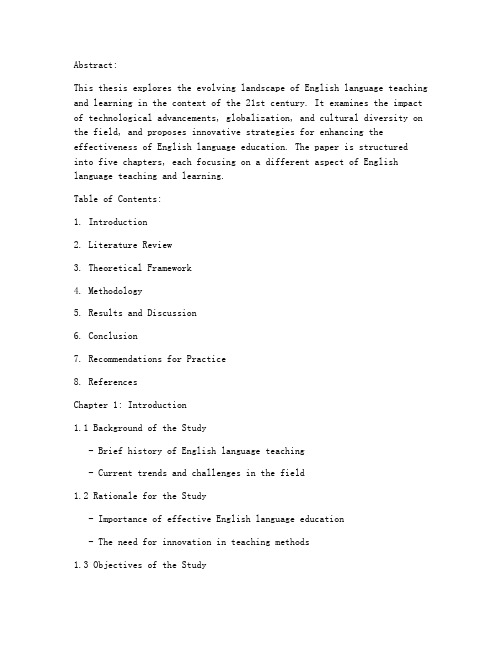
Abstract:This thesis explores the evolving landscape of English language teaching and learning in the context of the 21st century. It examines the impact of technological advancements, globalization, and cultural diversity on the field, and proposes innovative strategies for enhancing the effectiveness of English language education. The paper is structuredinto five chapters, each focusing on a different aspect of English language teaching and learning.Table of Contents:1. Introduction2. Literature Review3. Theoretical Framework4. Methodology5. Results and Discussion6. Conclusion7. Recommendations for Practice8. ReferencesChapter 1: Introduction1.1 Background of the Study- Brief history of English language teaching- Current trends and challenges in the field1.2 Rationale for the Study- Importance of effective English language education- The need for innovation in teaching methods1.3 Objectives of the Study- To investigate the impact of technology on English language teaching and learning- To analyze the role of globalization in shaping English language education- To explore the challenges of cultural diversity in the classroom1.4 Scope of the Study- Focus on English language teaching and learning in the 21st century- Emphasis on the global perspective1.5 Research Questions- How has technology influenced English language teaching and learning?- What is the role of globalization in shaping English language education?- What challenges do teachers face in managing cultural diversity in the classroom?Chapter 2: Literature Review2.1 Historical Perspective- Evolution of English language teaching methodologies- Key theories and approaches in English language pedagogy2.2 Technological Integration- The role of technology in language learning- Case studies of technology-assisted language learning (TALL)2.3 Globalization and English Language Education- The spread of English as a global lingua franca- Impact of globalization on language teaching and learning2.4 Cultural Diversity in the Classroom- The challenge of cultural differences in language learning- Strategies for promoting cultural sensitivity and inclusivity2.5 Current Trends and Challenges- Emerging issues in English language education- The future of English language teaching and learningChapter 3: Theoretical Framework3.1 Theoretical Foundations- Language acquisition theories- Sociocultural theories of learning3.2 Pedagogical Approaches- Communicative language teaching (CLT)- Task-based language teaching (TBLT)3.3 Technological Tools- Virtual reality (VR) and augmented reality (AR) in language learning- Artificial intelligence (AI) and machine learning in language education3.4 Cultural Competence- Definition and importance of cultural competence- Strategies for developing cultural competence in language learnersChapter 4: Methodology4.1 Research Design- Qualitative and quantitative research methods- Mixed-methods approach4.2 Data Collection- Surveys and questionnaires- Interviews- Classroom observations4.3 Data Analysis- Content analysis- Statistical analysis4.4 Ethical Considerations- Informed consent- Confidentiality and privacyChapter 5: Results and Discussion5.1 Analysis of Survey Data- Teachers’ perceptions of technology in language teaching- Students’ experiences with technology-assisted language learning 5.2 Interviews with Teachers- Challenges faced by teachers in integrating technology- Strategies for managing cultural diversity5.3 Classroom Observations- Examples of effective technology integration in language classes - Strategies for promoting cultural sensitivity5.4 Discussion- Interpreting the results in the context of existing literature- Identifying patterns and trends in the dataChapter 6: Conclusion6.1 Summary of Findings- Key insights from the study- Relevance to the field of English language teaching and learning 6.2 Limitations of the Study- Methodological limitations- Scope limitations6.3 Implications for Future Research- Suggestions for further investigation- Areas for future explorationChapter 7: Recommendations for Practice7.1 Recommendations for Teachers- Strategies for integrating technology into language teaching- Approaches for managing cultural diversity in the classroom7.2 Recommendations for Policy Makers- The need for infrastructure development- Importance of professional development for teachers7.3 Recommendations for Language Learners- Tips for effective language learning- The importance of cultural awarenessChapter 8: References[Include a comprehensive list of all the sources cited in the thesis, formatted according to the chosen citation style (e.g., APA, MLA, Chicago).]Appendices[Optional appendices containing additional materials such as survey instruments, interview transcripts, and detailed data analysis.]Note: This template provides a general structure for an English professional graduate thesis. The actual content and depth of each section will vary based on the specific research questions, methodology, and theoretical framework chosen by the researcher.。
英语专业毕业论文提纲

英语专业毕业论⽂提纲英语专业毕业论⽂提纲 时间过得真快,⼤学⽣活即将结束,我们都知道毕业前要通过毕业论⽂,毕业论⽂是⼀种⽐较重要的`检验⼤学学习成果的形式,毕业论⽂我们应该怎么写呢?下⾯是⼩编精⼼整理的英语专业毕业论⽂提纲,欢迎⼤家借鉴与参考,希望对⼤家有所帮助。
英语专业毕业论⽂提纲篇1 Acknowledgements 4-6 Contents 6-10 List of Figures 10-12 List of Tables 12-20 Abstract 20-22 摘要 23-25 Chapter 1 Introduction 25-32 1.1 Purpose of the study and research questions 28-29 1.2 Significance of the study 29-30 1.3 Organization of the study 30-31 1.4 A note on terminology 31-32 Chapter 2 Literature review 32-51 2.1 T/TP and coherence in English writing 32-35 2.1.1 Defining coherence 32-33 2.1.2 T/TP as means to realize coherence 33-35 2.2 T/TP in EFL/ESL writing 35-42 2.2.1 T/TP and coherence in EFL/ESL writing 35-37 2.2.2 T/TP in EFL/ESL writing as compared to NS writing 37-42 2.3 T/TP in English research articles by EFL/ESL scholars 42-44 2.4 The factors that influence T/TP in EFL/ESL writing 44-47 2.5 Training in T/TP 47-49 2.6 Summary 49-51 Chapter 3 Theoretical background 51-70 3.1 Systemic Functional Grammar 51-55 3.1.1 Five dimensions of language as a semiotic system 51-53 3.1.2 Three metafunctions of language as a functional system 53-54 3.1.3 Three lines of meaning from metafunctions 54-55 3.2 Theme and thematic progression 55-70 3.2.1 Theme 56-62 3.2.2 Thematic progression 62-70 Chapter 4 Research Design 70-88 4.1 The participants and the educational context 70-73 4.1.1 Background of the participants and the participating school 70 4.1.2 The allocation of participants to the training 70-71 4.1.3 The sample sizes 71-72 4.1.4 The pilot study 72-73 4.2 The interventional procedures 73-74 4.3 The questionnaire 74-75 4.4 The training 75-80 4.4.1 Considerations behind the training 75-76 4.4.2 The training material 76-79 4.4.3 The role of the researcher as the trainer 79-80 4.5 Data analysis 80-86 4.5.1 Analysis of the writing 80-86 4.5.2 Analysis of the questionnaire 86 4.6 Ethical considerations 86-88 4.6.1 Informed consent 86-87 4.6.2 Anonymity 87 4.6.3 Harm 87-88 Chapter 5 Results and analysis of pre-training writing 88-115 5.1 Comparison of Themes in EEL pre-training writing and CEL pre-writing 88-102 5.1.1 Topical,textual and interpersonal Themes 88-91 5.1.2 Topical Themes:marked and unmarked Themes 91-95 5.1.3 Textual Themes:continuatives,conjunctions and conjunctive adjuncts 95-100 5.1.4 Interpersonal Themes 100-102 5.2 Comparison of thematic progression in EEL pre-training writing and CEL pre-writing 102-110 5.2.1 Linear,constant,summative and split progressions 102-107 5.2.2 Back,contextual and new Themes 107-110 5.3 Summary 110-115 Chapter 6 Results and analysis of post-training writing 115-137 6.1 Comparison of Themes in EEL post-training writing and CEL post-writing 115-129 6.1.1 Topical,textual and interpersonal Themes 115-117 6.1.2 Topical Themes:marked and unmarked Themes 117-121 6.1.3 Textual Themes:continuatives,conjunctions and conjunctive adjuncts 121-126 6.1.4 Interpersonal Themes 126-129 6.2 Comparison of thematic progression in EEL post-training writing and CEL post-writing 129-132 6.2.1 Linear,constant,summative and split progressions 129-131 6.2.2 Back,contextual and new Themes 131-132 6.3 Summary 132-137 Chapter 7 Results and analysis of pre- and post- training writing 137-155 7.1 Comparison of Themes in pre- and post- training writing 137-147 7.1.1 Topical,textual and interpersonal Themes 137-139 7.1.2 Topical Themes:marked and unmarked Themes 139-142 7.1.3 Textual Themes:continuatives,conjunctions and conjunctive adjuncts 142-145 7.1.4 Interpersonal Themes 145-147 7.2 Comparison of thematic progression in pre- and post- training writing 147-150 7.2.1 Linear,constant,summative and split progressions 147-149 7.2.2 Back,contextual and new Themes 149-150 7.3 Summary 150-155 Chapter 8 Results and analysis of the questionnaire 155-165 8.1 Findings from closed questions 155-160 8.1.1 EEL participants general attitude to training on T/TP 155-157 8.1.2 EEL participants perception of the usefulness of the training on T/TP 157-158 8.1.3 EEL participants perception of the learnability of T/TP 158-159 8.1.4 EEL participants perception of the applicability of T/TP in writing 159-160 8.2 Findings from open questions 160-164 8.2.1 The changes that occurred 161-162 8.2.2 The perceived difficulty of applying the theory of T/TP in writing 162-163 8.2.3 The reasons for the perceived difficulty in learning 163 8.2.4 EEL participants suggestions for future training 163-164 8.3 Summary 164-165 Chapter 9 Discussion 165-195 9.1 Findings with regard to research questions 165-187 9.1.1 Chinese college students use of T/TP in pre-training writing 165-172 9.1.2 Chinese college students use of T/TP in post-training writing 172-181 9.1.3 Effects of the training on T/TP in Chinese college students English writing 181-187 9.2 Positioning the study within the literature 187-190 9.2.1 T/TP in Chinese college students English writing 187-189 9.2.2 Effects of training on Chinese college students use of T/TP 189-190 9.3 Implications 190-194 9.3.1 Pedagogical implication 190-193 9.3.2 Methodological implication 193-194 9.4 Limitations 194-195 Chapter 10 Conclusion 195-200 10.1 Summary 195-197 10.2 Putting everything together 197-199 10.3 Suggestions for future work 199-200 Notes 200-202 References 202-214 Appendix 1: Plan for the interventional procedures 214-215 Appendix 2: The post-training questionnaire 215-217 Appendix 3: Training material 217-229 Appendix 4: Teachers guide to the training 229-237 Appendix 5: Consent form for EEL group 237-238 Appendix 6: Consent form for CEL group 238-239 Appendix 7: Consent form for NS group 239 英语专业毕业论⽂提纲篇2 中⽂摘要 3-4 ABSTRACT 4 Chapter One Introduction 7-10 1.1 Motivation of the present study 7-8 1.2 Significance of this study 8 1.3 Composition of this thesis 8-10 Chapter Two Literature Review 10-19 2.1 Language production 10-14 2.1.1 L1 Production 10-11 2.1.2 L2 Production 11-12 2.1.3 Dimensions of language production 12-14 2.2 Theories on oral output 14-15 2.2.1 Skehan’s dual-model system 14 2.2.2 Swain’s Output Hypothesis 14-15 2.3 Task Repetition 15-17 2.3.1 Task 15-16 2.3.2 Task repetition 16-17 2.4 Relevant studies on effects of task repetition on L2 oral output 17-19 CHARPTER THREE THE CURRENT STUDY 19-25 3.1 Research justification and questions 19 3.2 Hypothesis 19-20 3.3 Methods 20-25 3.3.1 Participants 20-21 3.3.2 Material 21 3.3.3 Research design 21-23 3.3.4 Measures 23-25 Chapter Four Results and Discussion 25-41 4.1 Results and Analysis 25-34 4.1.1 Quantitative analysis 25-27 4.1.2 Qualitative analysis 27-34 4.2 Discussion 34-41 4.2.1 Fluency 34-36 4.2.2 Complexity 36-38 4.2.3 Accuracy 38-39 4.2.4 interlanguage development path of learner L 39-41 Chapter Five Conclusions 41-44 5.1 Conclusion and implication 41-43 5.2 Limitations and recommendations 43-44 Acknowledgements 44-45 References 45-49 Appendixes 49-54 A. Instructions of the experiment 49-50 B. The same-content task 50-51 C. The different-content task 51-52 D. Sample of oral pre-task 52-53 E. Sample of oral post-task 53-54 F. Sample of writing repetition task 54 英语专业毕业论⽂提纲篇3 Abstract 3-4 摘要 5-8 List of Abbreviations 8-9 Chapter One Introduction 9-13 1.1 Research Background 9-11 1.2 Necessity and Objectives of the Study 11-12 1.3 Thesis Organization 12-13 Chapter Two Literature Review 13-27 2.1 Defining Explicit Linguistic Knowledge (ELK) and Implicit Linguistic Knowledge (ILK) 13-16 2.2 Relationship Between Explicit and Implicit Knowledge 16-19。
英语专业文学论文提纲
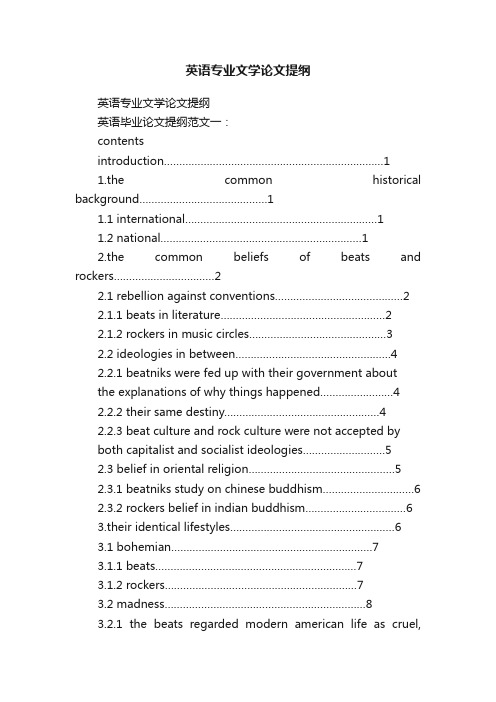
英语专业文学论文提纲英语专业文学论文提纲英语毕业论文提纲范文一:contentsintroduction (1)1.the common historical background (1)1.1 international (1)1.2 national (1)2.the common beliefs of beats and rockers (2)2.1 rebellion against conventions (2)2.1.1 beats in literature (2)2.1.2 rockers in music circles (3)2.2 ideologies in between (4)2.2.1 beatniks were fed up with their government aboutthe explanations of why things happened (4)2.2.2 their same destiny (4)2.2.3 beat culture and rock culture were not accepted byboth capitalist and socialist ideolog ies (5)2.3 belief in oriental religion (5)2.3.1 beatniks study on chinese buddhism (6)2.3.2 rockers belief in indian buddhism (6)3.their identical lifestyles (6)3.1 bohemian (7)3.1.1 beats (7)3.1.2 rockers (7)3.2 madness (8)3.2.1 the beats regarded modern american life as cruel,selfish,and impersonal that writers and artists were being drivento madness (8)3.2.2 rockers were mad enough to drive rockniks crazy onrock circus spot (9)3.3 self-indulgent (9)3.3.1 drugs (9)3.3.2 homosexual (10)4. the same conduct (10)4.1 beat s of satan and angles (10)4.2 rockers' conduct of the two sides (11)conclusion (13)英语毕业论文提纲范文二:摘要:The thesis statement should be as specific as possible. By writing a specific thesis statement, you focus on your subject and give yourself and your reader a clearer idea of what will follow in the body of the essay.your plan, and later in your essay, follow a logical order. The rule for writing is this: use your common sense and plan ahead. Do not leave the order of your paragraphs to chance.How many types of order can be used in thesis writing?What are they?Ordering the Paragraphs within the EssayThe types of order often used in single paragraphs— time order, space order, and order of climax— can sometimes be used to arrange paragraphs within an essay. Essays about subjects that can be broken into stages,with each step discussed in one paragraph, should be arranged according to time. Space order is used occasionally in descriptive essays.A writer who wishes to save the most important or convincing paragraph for last would use order of climax. Or he or she might wish to reverse this order and put the most important paragraph first.Very often, however, the writer simply arranges paragraphs in whatever order makes sense in that particular essay.Expanding the One-paragraph PlanAn essay is like an expanded paragraph.For this reason, any plan for developing a paragraph can also be used to develop an entire essay.It is up to the careful writer to choose the pattern that is best suited to his or her purpose and to the kind of essay required.Linking Paragraphs within the BodyJust as the sentence within a paragraph should flow smoothly, so the paragraphs within an essay should be clearly linked one to the next. As you write your essay,do not make illogical jumps from one paragraph to another. Instead, guide your reader. Link the first sentence of each new paragraph to the thesis statement or to the paragraph before.Here are four ways to link paragraphs:Linking Paragraphs within the BodyRepeat key words or ideas from the thesis statement.Refer to words or ideas from preceding paragraph. Link the first sentence of a new paragraph to the paragraph before, especially by referring to words or ideas near the end of that paragraph.Use transitional expressionsUse transitional sentencesUse all four methods of linking paragraphs as you write your essay.ChecklistNarrow the topic to one that you can discuss fully and well in an essay.Write a clear statement.Brainstorm ideas to support your statement.Choose some main ideas to support the thesis statement.Write a topic sentence that expresses each idea.Decide on a logical order in which to present the paragraphs in the body.Plan the body of each paragraph, using paragraph development.Write the first draft of your essay, linking paragraphs clearly to each other.Check for unity, logic, and coherence; revise and rewrite as necessary.Proofread for errors in grammar, sentence, structure, spelling, and mechanics.Three Types of Common Errors:Language/Ideas/FormatConsideration: How many kinds of specific errors you are likely to make in your writing? How to avoid them?。
英语专业的论文提纲
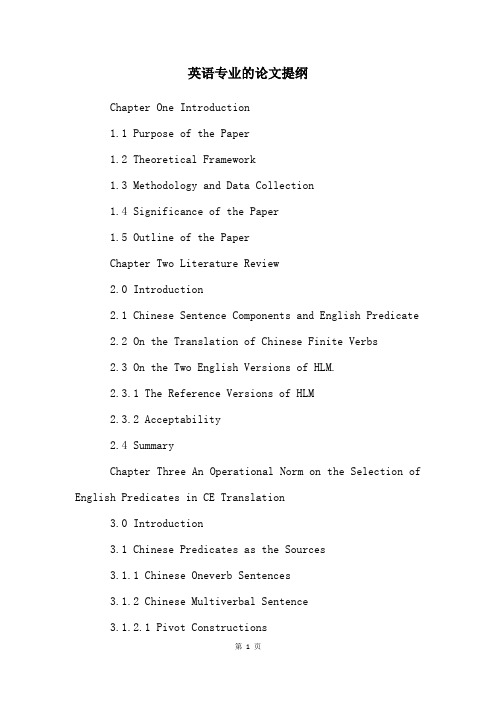
英语专业的论文提纲Chapter One Introduction1.1 Purpose of the Paper1.2 Theoretical Framework1.3 Methodology and Data Collection1.4 Significance of the Paper1.5 Outline of the PaperChapter Two Literature Review2.0 Introduction2.1 Chinese Sentence Components and English Predicate 2.2 On the Translation of Chinese Finite Verbs2.3 On the Two English Versions of HLM.2.3.1 The Reference Versions of HLM2.3.2 Acceptability2.4 SummaryChapter Three An Operational Norm on the Selection of English Predicates in CE Translation3.0 Introduction3.1 Chinese Predicates as the Sources3.1.1 Chinese Oneverb Sentences3.1.2 Chinese Multiverbal Sentence3.1.2.1 Pivot Constructions3.1.2.2 Serial Verbal Constructions3.1.2.3 Constructions with Subjectpredicate Phrases 3.2 Empty Categories as the Sources3.3 Chinese Adverbials as the Sources3.4 SummaryChapter Four The Textuallinguistic Norm on the Translation of Chinese Verbs in CE Translation4.0 Introduction4.1 Similarities between the Yangs Version and Hawkes,Version in English Counterparts of Chinese Verbs in CE Translation4.1.1 Verb 〔Verbal Phrase〕4.1.2 Empty Categories4.1.3 Nonfinite Verb 〔Verbal Phrase〕4.1.3.1 Participle4.1.3.2 Infinitive 〔Phrase〕4.1.4 Preposition 〔Prepositional Phrase〕4.1.5 Noun4.1.6 Adverb4.1.7 Adjective4.1.8 Auxiliary4.2 Discrepancies between the Yangs Version and HawkesVersion in English Counterparts of Chinese Verbs4.2.1 Verb4.2.2 Preposition4.2.3 Noun4.2.4 Adjectives4.2.5 Empty Categories4.2.5.1 Empty Categories in the Yangs,Version4.2.5.2 Addition in Hawkess Version4.3 SummaryChapter Five Constraints on the Selection of English Predicate in CE Translation5.0 Introduction5.1 Constraints from the Initial Norm5.2 Constrains from the Preliminary Norms5.3 Constrains from the Textuallinguistic Norms5.3.1 From the Perspective of Discourse Theme5.3.2 From the Perspective of Syntax5.3.2.1 Chinese Sentence with Overt Subject5.3.2.1.1 Same Subject between the Two English Versions of HLM655.3.2.1.2 Different Subjects between the Two English Versions of HLM. 665.3.2.2 Chinese Sentence with Covert Subject5.3.2.2.1 Same Subject between the Two English Versions of HLM5.3.2.2.2 Different Subjects between the Two English Versions of HLM.685.3.3 From the Perspective of Word5.3.3.1 Motion + Path5.3.3.2 Motion + Coevent5.4 SummaryChapter Six Conclusions6.1 Findings6.2 Limitations and SuggestionsThis conclusionBased on the third chapter of HLMmd its two English versions, this thesis explores howto select English predicates in CE translation through the comparison between the originaltext, the Yangs5 version and Hawkes,version with Toxirys threephase methodology. Thisstudy finds out that, on the selection of English predicates, the translators have adopted thefollowing three norms. The initial norm is to subject to the target culture: previous studieshave proved that compared with the Yangs, Hawkess version, complying with thisnorm,ismore popular among TRs. The preliminary norm is to subject themselves to the translationpolicy in their own translational context. Though the two translators have chosen the same ST,they are in different translational contexts and have different translation purposes: Hawkes,considering the contradiction between the westerners curiosity about China and Chineseliterature and the deficiency of translated Chinese literature in the Western World, determinesto fill up this blank and provide a window for the TRs to get a glimpse of China; whereas, theYangs are appointed by the Foreign Language Press to fulfill the mission of spreading theChinese literature to the west. Different translation purposes cause different translationstrategies, which,in turn, lead to discrepancies in the acceptability of the TT. In China, theYangs version is unsurpassable, but at abroad, the Hawkess version is in the toprankingamong the English versions of HLM. As for the operational norm, it has been concluded thatthe higher syntactic status the English predicate occupies, the higher information value itconveys, which determines that normally the selected English predicate will be incorrespondence with the original syntactic component which also enjoys a higher syntacticstatus as well as possesses a higher information valueand that finding is also reflected in thefollowing way: the element loaded with the information about the result of an event in the ST,for example, the Chinese verb indicating the result of an event, is normally rendered into anelement with a higher syntactic status in the TT, such as, the English mainclause predicateverbs. Apart from that, the selection of English predicates will also be constrained by thediscourse theme of ST, English subjects and different lexicalization levels between Chineseand English.All in all, this research attempts to shed light on the study of translation process andbring about inspiration to translation teaching and practice.。
- 1、下载文档前请自行甄别文档内容的完整性,平台不提供额外的编辑、内容补充、找答案等附加服务。
- 2、"仅部分预览"的文档,不可在线预览部分如存在完整性等问题,可反馈申请退款(可完整预览的文档不适用该条件!)。
- 3、如文档侵犯您的权益,请联系客服反馈,我们会尽快为您处理(人工客服工作时间:9:00-18:30)。
外语系英语专业毕业论文大纲
一、总纲
毕业论文,是大学本科教学的最后一个环节。
是对整个大学阶段学习的回顾与总结,是学生综合能力的体现,也是对学生的一次语言及相关科学研究的一次基本训练,因此,要求学生以高度认真负责的态度对待此项工作。
做好毕业论文的指导工作是整个大学教学的重要和必要内容,也是理论教学的重要组成部分。
每一位教师都要以高度的社会责任感和敬业精神投入到此项工作中去,指导学生顺利完成毕业论文任务。
二、毕业论文的阶段及要求
论文工作主要分以下几个阶段:准备(资料的收集与整理、阅读文献)、撰写提纲、第一稿、第二稿、第三稿、定稿与答辩。
(一)准备:学生可以自由选择研究范围(语言、文学、文化、社会问题、应用英语、经济、贸易、科技、社会生活等),但要在教师的指导下对研究对象进行资料的收集整理和分析来确定毕业论文题目。
(二)撰写提纲:学生在指导教师的指导下分析和研究所采集的资料的基础上,撰写毕业论文提纲。
同时也要求每一位指导教师在学生形成毕业论文提纲前一定要与每位被指导的学生进行讨论,毕业论文提纲应尽量做到全面缜密,理顺所要论述内容,避免以后反复修改。
(三)第一稿:要求学生必须严格按照指导教师审定后的毕业论文提纲进行写作, 不可自行其是,随意更换主题。
第一稿完成以后,指导教师主要检查学生是否按照既定的提纲和思想在写作,及时发现问题及时纠正。
如学生采取不认真的态度,指导教师应对其提出严肃的批评教育,拒不接受者,指导教师有权提出相应的处理意见,或交系里处理。
如果指导教师不认真指导,以后阶段出现的问题由该教师本人负责。
(四)第二稿:要求学生不仅要继续补充第一稿之不足,同时要求在表达上要有所提高。
在接到第二稿以后,指导教师阅读后应指出存在的问题,以便学生及时改正。
(五)第三稿:要求学生在文风、文章格式、修辞等方面有所提高。
指导教师要对第三稿进行全面的审阅,并提出修改意见,以保证定稿打印时所有的错误和疏漏都得到更正,错误率控制在规定范围内。
同时,教师还要提醒学生在打印前再校对,以保证尽可能地将正确的版本打印出来。
(六)毕业论文答辩:毕业论文的答辩是毕业论文工作的最后阶段,要求学生予以充分的准备和重视。
论文答辩前,学生们必须充分熟悉论文,答辩时,要求学生能脱稿进行5~10分钟的毕业论文内容的陈述,并流利、准确地回答答辩委员提出的问题。
在答辩过程中,参加答辩的教师要对答辩人的语言技能(语音、语法、词汇、语用)、口笔头能力、论文内容和答辩的表现进行认真纪录,客观公
正地评分。
三、毕业论文的内容:
毕业论文的内容可以涉及语言知识、与语言有关的问题(如,语言教学、文化等)和相关专业的知识和内容(如经济、贸易、管理、金融等)。
其他内容,须经论文审题小组集体审定。
学生有选择论文内容的自由,指导教师可以提出建议,但不能代替学生做出决定。
论文内容要能反映社会和时代特征,具有理论价值或实践意义,有新颖性。
论文可以对某个理论问题的探讨,也可以是实践问题的解决。
论文不仅要反映学生的综合能力,而且要反映他们对相关问题的较为正确的论述,要有一定的独立见解。
论文必须做到主题明确、论据清晰、内容具体而充实,切忌空谈。
写翻译的论文,除实例分析外,还要提供原文的译文,以便弄清译论的依据。
如果论文是实践性的,它必须提出一定的解决途径、方案。
四、毕业论文的评审:
指导教师在对论文评定成绩时,要参照学生的学习成绩、平时表现出的语言水平和专业四、八级考试的成绩,以正确衡量学生真实的语言和认识水平。
指导教师对学生的毕业论文成绩提出异议,如不被采纳,可提交外语系毕业论文工作小组商议和仲裁。
指导教师如发现学生的毕业论文有抄袭现象,应及时向学生指出,学生若不接受批评,指导教师应提交到外语系毕业论文工作小组处理,严重者取消论文资格。
指导教师应杜绝送分的做法,也不可因个人原因影响对学生论文评价的客观性和公正性。
五、论文的格式:
论文的规格:正文长度3,0 00—5,000 单词。
使用的语言:英语.。
论文分题目、引言、正文、参考文献、致谢等部分。
引文要注明出处。
直接引用要加引号,间接引文要以转述的方式出现。
然后以括号把引文来源写清楚:(作者名,年份,引文所在页码)
论文正文部分:
1、论文正文均用小四号字,新时代罗马字体;一级标题使用三号字,二
级标题使用四号字,三级及三级以下标题使用小四号字;标题统一使
用黑体字,,1.5倍行距
2、作者名,小4号字,班级,学号;
3、指导教师名,小4号字,职称;
4、摘要:250-300词,小4号字, 英文一页,中文一页;
5、关键词:4-7个。
不能用专有名词,词与词之间空四格(或一个Tab键),
不加标点符号;
6、正文:用小4号字, 标题用小4号字黑体,数字用罗马字,次部分用一
般数字符号。
如:
I. II. III. IV. V. VI. VII. VIII. IX. X
II. 1.1, 1.2, 1.3, 1.4, 1.5 ...
III. 1.1.1, 1.1.2, 1.1.3/ 2.1.1, 2.1.2, 2.1.3, / 3.1.1. …;
7、参考文献(Bibliography):先英文,后中文。
作者名,出版年月,文章名
/书刊名,出版社,地点;
8、致谢(Acknowledgement)
六、毕业论文质量标准
(一)选题恰当、与毕业生的知识水平与认识能力相当;
(二)内容丰富、资料翔实、论证充分有力;
(三)观点正确、逻辑性强、无违反国家大政方针的观点
(四)叙述清楚、层次清晰而丰富;
(五)语言表达正确,无拼写错误、语言错误控制在20-25%00(万分之二十到二十五);
(六)用词、造句、谋篇、布局等方面无明显失误,修辞错误率控制在2%。
新疆财经学院外语系
2007-1。
